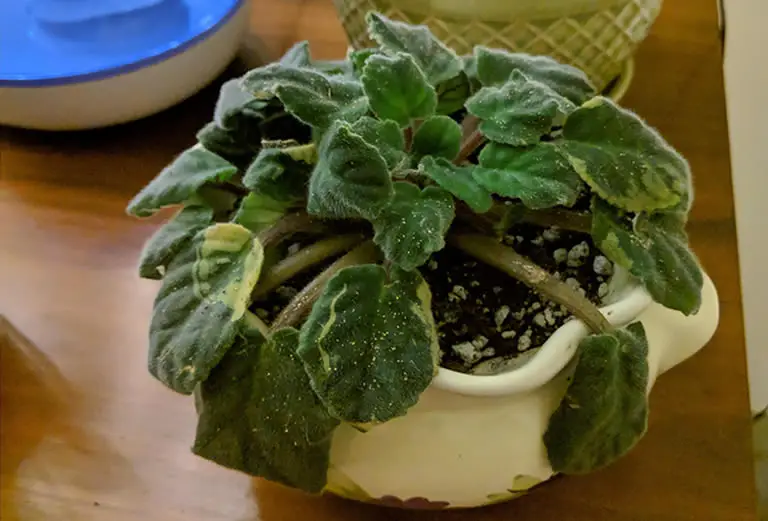African violet is an easy-care flowering perennial that is a popular houseplant in America. Although most owners will have little to no problems growing this plant, a common complaint among african violet owners is drooping leaves. In this article I outline what causes this common problem and the fixes you can employ to revive your plant.
Table of Contents
Why are my african violet leaves drooping? It’s all about the watering
So what causes african violet leaves to start drooping?
Dehydration is almost always the cause for drooping leaves on an african violet.
However, dehydration can be caused by underwatering, and as strange as it may seem, it can also be caused by overwatering (I’ll explain how this happens in more detail later).
African violet leaves start drooping when they are receiving insufficient water.
This may be due to underwatering by the owner but can also be caused by root rot due to overwatering.
Once the cause is identified the plant can usually be saved.
Before you take action to revive your drooping african violet plant it is essential you identify the problem that is causing your plant to become dehydrated.
The cause for the dehydration and drooping leaves on an african violet is a lack of water getting to the leaves.
This is almost always due to a poor watering routine (though the fault can sometimes lie with the pot as you will see later).
You should note that a poor watering routine does not necessarily mean you have been underwatering the plant. Read our extensive guide to watering african violets for more information.
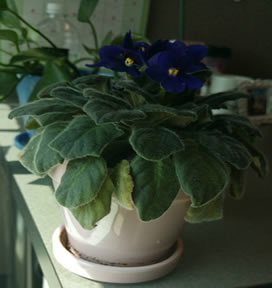
Now, although the most obvious cause for a lack of water reaching african violet leaves, and thus causing drooping leaves, is insufficient water being given to the plant, this is not always the case.
As counterintuitive as it sounds, overwatering an african violet can also deprive the plant of water. How so?
When you overwater an african violet plant, or when the plant’s pot has insufficient drainage, the buildup of water in the soil can cause root rot.
Root rot will restrict the roots from absorbing water and inhib their ability to send it to the foliage of the plant.
So how do you identify which specific problem is causing a lack of water reaching the leaves?
How to identify the cause of the dehydration behind drooping african violet leaves
Before I outline the steps to take to revive your african violet I need to help you identify the actual cause behind the dehydration of your plant’s leaves.
As I said before, what may appear to be the most obvious cause for drooping leaves, i.e. a lack of water in the soil, may not be the cause at all.
In fact I have found that 8 times out of 10 the cause is not a lack of water in the soil but too much water in it.
But how do you know which cause is behind your specific plant’s problem?
I will cover both potential causes now and show you how to identify which one is causing the problem with your african violet.
Underwatering can cause african violet wilting
African violets require much less water than most other houseplants but they still require regular watering.
As african violet resemble desert succulents many owners mistakenly believe they can leave their plant without water for weeks at a time. This is rarely the case.
African violets should be watered when the top layer of soil in the pot dries out. As long as the pot has good drainage this drying out of the top layer indicates that the soil requires watering.
You can water african violet from the bottom or the top as long as you are careful to avoid getting water on the leaves (see my african violet leaf care guide).
I personally water african violets from the top but will occasionally give them a 20 minute soak in a few inches of water, if we are experiencing unusually warm weather and the soil seems to be drying out quicker than normal.
This is the equivalent of giving my plant a nice long cool drink of water.
To determine if the cause of your african violet having droopy leaves is just a lack of water in the soil you should inspect the lower stem of the leaves for signs of blackening (as outlined below). Also check the soil for moistness.
If the soil is completely dry then you’ve found your culprit, but if the soil is moist and the leaves are still drooping it is much more likely the plant has a problem at the roots.
Although I can usually tell within a minute or so if the cause of droopy leaves on an african violet are simply due to insufficient watering. This is due to years of experience.
If you don’t have a lot of experience with this plant and are unsure then you may want to gently remove the plant from its container to have a better look at what is going on in the deeper layers of soil.
Something to remember: African violets require a pot that has good drainage and that will allow access water to drain away.
Without proper drainage water can accumulate in the deeper parts of the pot.
The top layer of soil will still dry out, usually indicating that you need to water the plant, but unknown to you the lower layers of soil, where the roots are located, are still very wet.
So make sure your african violet is in a pot with good drainage. You may want to place a saucer under the pot to catch access water.
As you are about to learn, improper drainage in the pot can lead to an overwatering of the plant which in turn leads to root rot.
Overwatering can also lead to an african violet drooping
Overwatering an african violet plant will almost certainly lead to the plant developing a very serious condition known as root rot.
Root rot occurs when the roots of your plant start to rot away when they are allowed to sit in excess “standing water” that has accumulated in the soil.
As the roots begin to rot they become incapable of absorbing moisture from the soil, and thus they are incapable of distributing that water to the rest of the plant to keep it hydrated.
That water also carries with it nutrients in the soil.
The plant literally starves and dehydrates even though it has access to plenty of water.
Root rot is easy to identify. African violet leaves will show clear signs of root rot on the foliage.
Root rot is often accompanied by a blackening at the base of the stem (see image below).
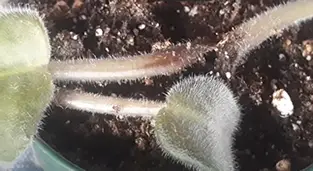
You may also find that when you handle the leaves to inspect them, them fall away easily from the plant.
Another clear sign that your african violet is suffering from root rot is droopy leaves even though the soil is damp or wet.
Droopy leaves are caused by a lack of water getting to the leaves so if the soil is damp or wet then you can be sure there is a problem with the roots and its ability to absorb and distribute this moisture.
Root rot is obviously a much more serious problem than simple underwatering and when you find your african violet is suffering from this you must take immediate action if you want to save your plant.
How to save a dying african violet
So how do you revive an african violet with drooping leaves?
To revive a wilted african violet you must first determine what is causing a lack of water reaching the leaves.
Watering an african violet that has simply been deprived of water will help revive it. But, if the cause is root rot then simply watering the plant will not be enough and will actually cause more harm.
Rot root requires more drastic measures.
As I have already mentioned drooping leaves on an african violet are always due to a lack of water getting to the leaves.
However, in most cases when an african violet plant displays drooping leaves the cause is not due to insufficient watering but actually due to overwatering.
When you overwater an african violet, or when the pot the plant sits in has poor drainage, the wet soil will cause the roots of the plant to start rotting.
Rotting roots are incapable of absorbing water and distributing it to the rest of the plant.
How to revive a wilted african violet step-by-step guide
Obviously if the roots of your african violet are in good shape all you have to do is water your plant and then ensure you maintain a proper watering routine thereafter.
Unfortunately, though it is much more likely that you have identified the problem of the drooping leaves as rot root.
So, below I show you how to treat root rot in an african violet and outline the steps you need to take to save your plant.
Be aware that there is no guarantee that the plant will survive. It really depends on how bad the root rot is, and on how much healthy plant remains.
However, it is worth it to try to save the plant as the steps you need to take are simple and quick.
How to treat root rot in african violets
You will need:
- Sharp scissors or gardening shears.
- A pointed knife.
- A small pot suitable for new plant cuttings (or a regular styrofoam cup).
- A clear plastic bag or grow bag.
Firstly, you will need to remove your plant from its pot. Do this gently as to not put any more stress on the violet than is necessary.
All parts of the plant that are showing signs of rot must be removed. This will almost certainly mean removing all the roots and several of the stems.
Cut away the infected roots with clean scissors or shears. I wipe the scissors with a small alcohol wipe after each cut just in case the root rot is caused by disease rather than overwatering.
By cleaning the scissors I kill any potential infection and prevent it from being spread to healthy parts of the plant.
As long as there is some healthy stem remaining on the plant you have a good shot as saving the african violet.
If the rot has reached all stems then the plant will not survive. In the image below you can see that there is still some healthy stem at the base of the plant just above the remaining infected roots.
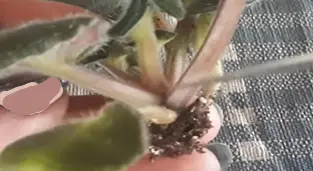
As you can see in the above picture there is still some infected parts of the plant at the base of the stem. This needs to be removed also.
Taking a pointed knife simply strip away any remaining rot so you are left with only uninfected parts of the plant.
Now that you have removed the infected parts of the plant the african violet should be replanted, using fresh soil (make sure you use the correct african violet soil).
Plant it in a small pot suitable for cultivating fresh cuttings or alternatively you can use a simple Styrofoam cup.
At this point the leaves on the african violet will still be dry and dehydrated.
However, without roots the plant has no way of absorbing moisture from the soil to send to the leaves.
So, it is a good idea to create some humidity around the plant to help the leaves get much-needed moisture.
How do you do this?
Take a small plastic grow bag, I prefer to use clear bags made from plants rather than plastic ones as they are more eco-friendly, but a plastic bag will suffice.
Place the bag over the plant and before you seal the top, pour a small amount of water into the bag so it sits at the bottom of the bag.
Don’t pour water into the pot.
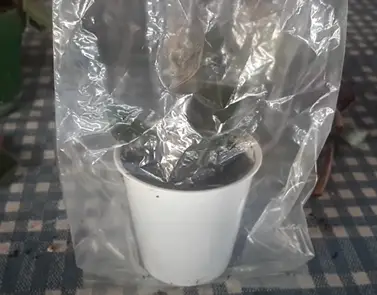
Using a clear bag in this way not only protects the african violet at this vulvernal regrowth stage, but it will also lock in moisture and, along with the water, create a localized humid atmosphere.
All being well, the african violet should start to develop new roots.
It will only take a few days to know if your actions to rejuvenate your african violet have been successful.
If you have been unsuccessful the plant will die.
Once the african violet has recovered you can replant it in fresh soil in a new pot.
If you intend using the plant’s original pot ensure you clean it thoroughly before replanting to remove the risk of reinfection in case the root rot was caused by disease rather than overwatering.
Personally, I just use a new pot.

